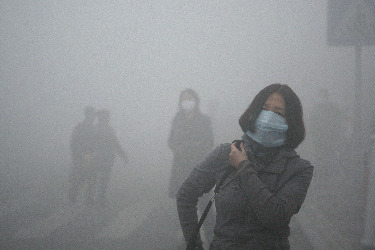China illustrates the true meaning of Direct Action on climate

By Dr Anthony Horton
With 37 days to go until the Paris Climate Change conference in December, a report released by the Paulson Institute in Beijing on Friday October 23 outlined a plan to accelerate the economic and environmental improvement transition in the Beijing-Tianjin-Hebei region in China, which last year was home to 130 million people and accounted for 10% of China’s GDP.
In addition to industrial areas, modern urban centres and districts trying to resist urban sprawl and maintain their rural character, the region is also called home by the largest steel and iron manufacturers in China, and some of the most polluted cities in the world. The steel, coke and cement industries are the largest greenhouse gas emitters in China.
According to a story in the weekend edition of the China Daily newspaper (24/25 October) which discussed the highlights of the report, the region is well placed to transition on the basis of its good infrastructure and relatively easy access to wind and solar power.
Former US Treasury Secretary Henry Paulson stated in an interview on the release of the report that in his opinion the next Five Year Plan (commencing in 2016) will be very ambitious and widely acclaimed. Figuring out how to make the Plan a reality will represent the biggest challenge though, and transitioning from “dirty” to “clean” plants without stifling growth was achievable but will take some time. Paulson also highlighted the huge opportunities that such a transition presents for international companies based on the size of the market for environmental goods and services.
Deputy Director of the Beijing Municipal Commission of Development and Reform, Wang Jiahui commented that it was possible to control air pollution, given the emissions reduction campaign conducted during APEC China last year. She also stated that nineteen coal fired power plants in Tianjin will meet the emission standards that gas fired stations are required to meet by the end of this year.
Liu Bozheng, also a Deputy Director of the Beijing Municipal Commission of Development and Reform announced that 1200 high energy consumption and highly polluting companies will be closed by 2017 rather than relocated to other regions. Four significant thermoelectric centres have been closed in Beijing and numerous coal fired boilers have been converted to gas boilers. A number of energy efficiency measures have also been implemented in Beijing as part of revamping more than 40 million square metres of office space.
Rather than simply revitalising industries in decline, the report recommended that City officers should identify opportunities for new growth industries. With respect to Hebei, officers should prioritise policies that promote renewable energy, energy efficiency and have strong growth and job creation potential, according to the Paulson Institute report.
I read the China Daily story on the flight from Beijing to Perth on Sunday, and have to admit that it brought to mind many of the conversations I had over the week I was in China. I was invited to speak on the role of innovation in the environmental protection space at the China Mining Conference and Exhibition 2015 in Tianjin, and in addition to speaking to a range of people in my session, I also spoke to many others over the three days of the conference.
After reflecting on the conference and the few days I spent in Beijing before and after, I left China with four main impressions. Firstly, there is an appreciation of the scale of transition that is required. There is also an understanding that the Green Mining Standard (initially conceived by the Ministry of Land and Resources in 2007) and the Guidance to Implement the National Mineral Resource Program, Develop Green Mining and Construct a Green Mine issued in 2010 (which essentially established a defined Green Mining Standard) is flexible enough to accommodate new knowledge and innovative approaches.
The Green Mining Standard takes into account nine operational aspects-operating legally, good practices, the efficient use of resources, technological innovation, limiting releases of wastes, environmental protection, reclamation, a harmonious relationship with the community and a good culture within the company.
Third, there is a willingness to listen to adopt learnings from international mining settings, and lastly (but by no means least), there is an optimism regarding what can be achieved in the short, medium and long term.
I am also heartened by the singularity of the messages I heard from Governments and Mining companies in China with respect to the need to protect the environments in which mining takes place as well as nearby ecosystems (which are linked in some way to those mined areas) as far as practicable and the importance of clear legislation and policies which facilitate that protection.
 About the author: Anthony Horton holds a PhD in Environmental Science, a Bachelor of Environmental Science with Honours and a Diploma of Carbon Management. He has a track record of delivering customised solutions in Academia, Government, the Mining Industry and Consulting based on the latest wisdom and his scientific background and experience in Climate/Atmospheric Science and Air Quality. Anthony’s work has been published in internationally recognised scientific journals and presented at international and national conferences, and he is currently on the Editorial Board of the Journal Nature Environment and Pollution Technology. Anthony also blogs on his own site, The Climate Change Guy.
About the author: Anthony Horton holds a PhD in Environmental Science, a Bachelor of Environmental Science with Honours and a Diploma of Carbon Management. He has a track record of delivering customised solutions in Academia, Government, the Mining Industry and Consulting based on the latest wisdom and his scientific background and experience in Climate/Atmospheric Science and Air Quality. Anthony’s work has been published in internationally recognised scientific journals and presented at international and national conferences, and he is currently on the Editorial Board of the Journal Nature Environment and Pollution Technology. Anthony also blogs on his own site, The Climate Change Guy.
Like what we do at The AIMN?
You’ll like it even more knowing that your donation will help us to keep up the good fight.
Chuck in a few bucks and see just how far it goes!
Your contribution to help with the running costs of this site will be gratefully accepted.
You can donate through PayPal or credit card via the button below, or donate via bank transfer: BSB: 062500; A/c no: 10495969









